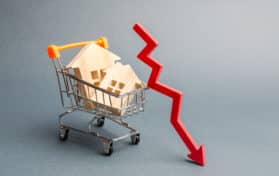
By definition, the supply chain is the method by which a company takes raw materials – crops, timber, or a plethora of other natural resources – and renders them into finished goods and/or services for customers. The beginning of the supply chain involves harvesting these raw materials, and then the materials are moved to the manufacturer’s facilities, where the process for turning raw material into a finished product takes place.
It’s important to remember that there are often multiple steps in the process of taking raw material from harvesting to the finished product. Furthermore, the harvested materials may be processed in a multitude of locations across a number of countries.
These facts show just how fragile the supply chain can be if just one element of the chain is broken.
Once a product has been fully converted from a raw material to the finished consumer product, then the item or items will end up in one of three places: the consumer, the retailer, or a wholesaler. Let’s look at how each of these places affect the supply chain.
Manufacturers
A handful of manufacturers are able to send products directly to the consumer. This takes place when a manufacturer has a catalog or a website of its own; some manufacturers have their own stores where they send the finished product straight to the shelf for consumer purchase. Some others will use a discount warehouse to hold the product until it is sold to the consumer.
Wholesalers
The wholesaler is typically the place where a finished product lands after the processing phase is completed. The wholesaler (sometimes a distributor) will then repackage the finished product for sale to the public. At this point in the supply chain, consumers will see the repacking into familiar names. The wholesaler will then send the product out to warehouses for retailers.
Retailers
Retailers offer both goods and services to the consumer. In addition to providing the product to the consumer, the retailer often offers services involving the product (i.e., the retailer often provides sales staff to help consumers select the best product for their purposes). Consumers will often pay for the privilege of having a retailer’s employee help them in selecting goods.
How does the supply chain affect the economy?
As a consumer, you’ve probably seen how the supply chain can affect the economy when you consider how supply and demand has contributed to higher prices. You’ve likely observed how the cargo ships sitting in ports out West have driven prices up at a time when the United States is already dealing with staggering inflation prices. However, the supply chain has many other effects on the overall economy of a country.
Legislators often bemoan the principles of supply-side economics, but, manufacturers must pay attention to their own bottom line. If a manufacturing company can save money by outsourcing their production, then the company will do so in order to save money.
Have you noticed if you needed to call your internet provider or cell phone provider’s customer service department that you’re typically speaking to someone overseas? That’s because that company has found it is cheaper to outsource these jobs than to keep them in the US. Many tech manufacturing jobs were outsourced to China or India over the last decade or so. Prior to that, when NAFTA was enacted, many manufacturing jobs in a factory setting left American shores for overseas operations.
We’ve also seen a plethora of natural disasters across the world that have all but halted the supply chain in some areas. According to the United Nations Refugee Agency, the occurrence of natural disasters as doubled over the last two decades. Unfortunately, even after a natural disaster has taken place and clean-up has begun, the supply chain in the affected area may be disrupted for years.
Take for instance the earthquake and resulting tsunami in Japan in 2011. This natural disaster caused a huge rift in the automobile manufacturing industry, in electronics, and in semiconductor equipment too. Many major components of an airplane are made in Japan, including wings and landing gear. In particular, the earthquake disrupted the manufacture of the Boeing 787 Dreamliner aircraft. In the automotive industry, twenty-two plants located in Japan had to halt production until the clean up was complete.
Managing the Supply Chain
Many manufacturing companies have begun to utilize something called vertical integration. Businesses, of course, oversee every phase of the manufacturing process in order to promote the greatest efficiency in manufacturing. Some of that management process has resulted in outsourcing jobs to Asia, while vertical integration is the other result. Vertical integration will allow for manufacturers to exert more control over the supply chain in the hopes that it will not be disrupted, but, in some ways, vertical integration almost appears to provide the company with a monopoly on the production of goods. Overall, vertical integration offers little to manufacturers in the way of flexibility.
What is Supply Chain Financing and How did it Help Companies Survive?
Supply chain financing was much like a pay-day loan for businesses. During the global credit crisis some years ago, both banks and large businesses had to find a way for businesses had to become creative when it came to keeping the supply chain moving. Suppliers would utilize invoices for shipments as collateral for low-interest loans from banks. Banks would approve the loan based on the credit-worthiness of the businesses receiving goods via the supply chain.
Banks were loathe to lend money during the global credit crisis, but with supply chain financing, small businesses were able to remain in operation. Companies that had a good shipping record were often approved for these loans, and, eventually, businesses were able to negotiate better financing rates.
Corporations truly helped one another during the global credit crisis. Corporations became more efficient as a result of these supply chain loans and cash became freed up. The treasurers of corporations began to find other ways to make sure their capital was invested in something “safe,” such as stock buybacks, bonds, and such.
Crises involving the supply chain have actually made corporations more savvy when it comes to business. When the global credit crisis took place, large companies realized that they could no longer rely on banks to provide them with extra capital if needed. So, they began to find creative ways to free up the cash they already had all while utilizing these supply chain financing loans if necessary. Banks were happy to provide loans based on a company’s ability to fulfill orders. Corporations then began to utilize cash on hand for other functions within the company.
Corporations have also found that if they can manage the supply chain with maximum efficiency, then they can maximize customer value, maximize the competitive advantage, and reduce overall costs to the company as well. This, of courses, boosts all company’s bottom line, and it keeps the supply chain moving along as it should.
However, companies must possess effective coordination of all facets of the supply chain. The company must efficiently control all linked sectors of the manufacturing process as well as all systems and departments involved in the supply chain process. Finally, all organizations that are a part of a corporation’s supply chain must be working in tandem for maximum efficiency.
When an organization is highly efficient at managing the supply chain, the company is not only more flexible and liquid, but they are no longer reliant solely upon banks for any extra capital they may need to stay afloat.





